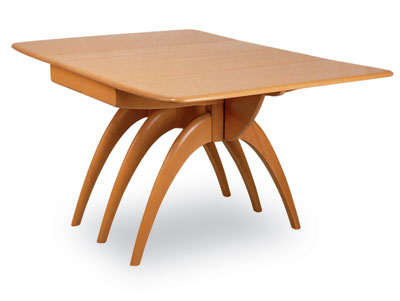Heywood-Wakefield Furniture | Antiques
In the 1930s, furniture from Heywood-Wakefield gave American homes a bright, fresh look. Today, you can find Heywood-Wakefield pieces at flea markets, thrift stores, consignment shops, and auctions—and they’re priced to sell. Sometimes I fear that modern-day Americans are like hothouse flowers: big, bold, beautiful, yet too fragile to survive outside a pristine environment. I […]

Coffee By Design | Portland, Maine
Photo Credit : Katherine KeenanIn the 1930s, furniture from Heywood-Wakefield gave American homes a bright, fresh look. Today, you can find Heywood-Wakefield pieces at flea markets, thrift stores, consignment shops, and auctions—and they’re priced to sell.

Photo Credit : Gertz, Harris
Sometimes I fear that modern-day Americans are like hothouse flowers: big, bold, beautiful, yet too fragile to survive outside a pristine environment. I hope I’m wrong, because given our social and economic woes, we’re going to have to learn to live in harsher climes. Let’s hope there will be those among us whose roots take hold and grow stronger–as happened during the 1930s. Although the Great Depression robbed many Americans of homes, businesses, and fortunes, for others it was a strangely motivating kick in the pants, spawning seeds of success that would bloom for years to follow. So goes the story of one such flower: the Heywood-Wakefield Company of Gardner, Massachusetts.
Founded in 1826 by five brothers—Walter, Levi, Seth, Benjamin (who never consented to be photographed), and William Heywood—the company began making simple wooden chairs in the family’s old barn. By 1897, Heywood Brothers had joined forces with the Wakefield Rattan Company. For the next three decades, the firm thrived, producing a wide range of finely crafted wood, wicker, and rattan furniture.
By the mid-1930s, Heywood-Wakefield was a venerable institution, but with furniture designs stuck in the 19th century, it was well positioned to fail with the onset of hard times. Rather than cling to its past, however, the company set a new course: creating the Heywood-Wakefield “Modern” series, a style of furniture so thoroughly futuristic that its fresh, vibrant look was mud in the eye to the despondency of the era. Optimistic Americans, eager to embrace a brighter view of things, ate it up.

Photo Credit : Gertz, Harris
Heywood-Wakefield Modern is just plain fun. Its simple lines and casual elegance connote a fresh start, a clean slate, a hopeful outlook. The collection’s signature look comes from solid Northern yellow birch, styled with rounded corners (achieved by steaming and bending the wood), a smooth, light-blonde finish, and zero ornamentation. Unlike some of the copycat versions that followed, it’s well made.
To get the look just right, the company sought out modern industrial designers, including Gilbert Rohde, Russel Wright, W. Joseph Carr, Leo Jiranek, and Count Alexis de Sakhnoffsky. These guys knew streamlined design and how to create it en masse on a production line. By the 1940s and ’50s, homes across America sported the blonde look: dining tables, chairs, bedroom sets, bookcases, cabinets, desks, side tables, and vanities, all from lines aptly tagged with modern-sounding monikers, such as “Sculptura,” “Crescendo,” and “Kohinoor.”
By the 1960s, however, the bloom was off the rose, and America’s love of Heywood-Wakefield Modern waned. Ironically enough, its demise was hastened by the firm’s focus on quality: The furniture was simply too expensive to produce. The last of the Modern line came out in 1966; the company declared bankruptcy in 1981.
But grieve not, Midcentury fans. Today you can find high-quality Heywood-Wakefield pieces at flea markets, thrift stores, consignment shops, and auctions, and they’re priced to sell: Anywhere from $25 to $500 could fetch you a masterpiece. That’s a fraction of what you’d pay retail for new reproductions, now being created and marketed once again as Heywood-Wakefield—so buyer beware.

Photo Credit : Gertz, Harris
I love these 1930s gems. They mix well with a variety of styles, and their once-so-futuristic profile is now a classic look. No matter the economic climate, the fresh fun of Heywood-Wakefield blooms eternal.
Catherine Riedel represents Skinner Auctioneers and Appraisers of Boston and Marlborough, Massachusetts. 617-350-5400, 508-970-3000; skinnerinc.com
For more on this era of furniture design, we recommend Heywood-Wakefield: A Schiffer Book for Designers & Collectors, by Harris Gertz (Schiffer Publishing, 2001).








I love the pedastal table. Hopefully i will be able to find an original piece.
I own the original desk, made by my great- grandfather John Olsen, that is one of a kind made for one of the Heywood’s office. John was a designer of furniture who came here from Sweden, lived in Gardner and later Westminster. Very unique piece of Heywood history.
my mom and i bought 2 pieces of hay-wake furniture at a garage sale in CT in 1973. one peice is (the best i can describe)a 3 leaf hinged clover leaf end table, the other i was told was a doughboy.i was wondering how i might be able to identify them somehow .any direction someone could give about how i might be able to find out the era of production and the like. i could care less about monetary value my thanx to anyone
I am the proud owner of the drop leaf table & 4 chairs. Also a buffet , desk, coffee table and end table.
I inherited.these from my gramd mother and will pass them on to my family.
Included with these was also a catalog from the 1950’s.
I have inherited Heywood wakefield drop leaf dining table the small bookcase also two end tables exactly the ones you are showing. I would like to know the best place to sell these are first owner furniture. Lee Collins
How do I refinish to Haywood end table? I picked 2 up up they need some touch up. What products should I use?